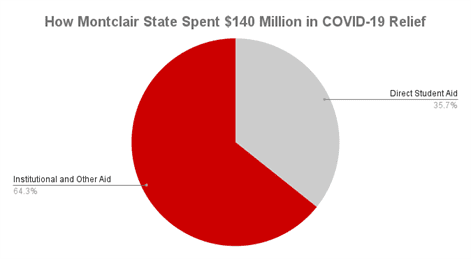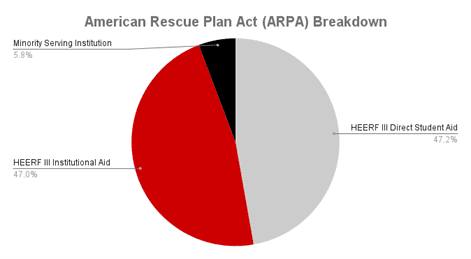Montclair State University received $140 million in funding for coronavirus (COVID-19) relief, but many students say they are unaware of this funding, according to an investigation by The Montclarion.
Despite the university’s efforts to get the word out, many students said they were unaware of the existence of the grants or the fact that they’re eligible for them.
Even students who applied for and received grants said their only source of information was a singular email.
Mateen Olanrewaju, a senior information technology major, said the school can do more to make students aware of this aid.
“They should let students know about it before because I remember I received an email about something like that,” Olanrewaju said. “I felt like it was too late because I already paid for my fall semester.”

Mateen Olanrewaju thinks the school can do a better job informing students.
John LaRosa | The Montclarion
The Coronavirus Aid, Relief and Economic Security (CARES) Act first established the Education Stabilization Fund as part of its over $2 trillion budget in spending, so that emergency relief could be disbursed to schools and universities after shutdowns due to the COVID-19 pandemic.
Of the $30.75 billion initially allocated to the fund, $47.7 million was awarded to Montclair State, with a significant portion through the Higher Education Emergency Relief Fund (HEERF). An additional $92.8 million came in through other COVID-19 stimulus bills, which includes the American Rescue Plan (ARP).
The Montclarion reached out to Montclair State administrators to request information regarding how much money has been dispersed to students so far. The data revealed the majority of funding has been spent, but there is still approximately $63 million remaining.
More than $50 million of the $140 million has gone directly to students or designated for students, the data shows. Most of the remaining funds were considered institutional aid used to cushion the blow from the initial COVID-19 pandemic.
That money was put toward reimbursements to residential students who had to move home as a result of the shutdown. Funding was also used in the purchase of technology to support remote learning and funding for free winter and summer courses as well as for students who had their education disrupted in the first wave of the pandemic.
Alexander Diaz, a freshman psychology major, said he was relieved to receive funding through HEERF.
“I thought I would have to work overtime at my job, but the HEERF aid will help me be able to pay my tuition for the spring semester,” Diaz said.
Another issue that has popped up is the matter of eligibility. Many students said they did not know if they were eligible for HEERF grants due to their financial status. Under new guidelines established by the federal government, any student enrolled at an institution that received COVID-19 relief funds is eligible to receive a grant. This is an expansion from previous bills, which limited grants to those who were eligible for Title IV grants or had already filled out a Free Application for Federal Student Aid (FAFSA).
Alejandra Linares Martinez, a senior product design major, was granted $1,000 in aid to help cover the cost of design programs she had to purchase to continue with her studies.
“I filled out the form and I totally forgot about it,” Linares Martinez said. “Three months later, I got money in my account.”
However, there were a number of students who felt the school needs to do a better job of getting the word out.
Emily Nause, a senior public relations major, said the school is not doing enough to inform students about these funds.
“I’ve never heard of it before,” Nause said.

Emily Nause was not even aware of the CARES act, and said the school should do more to inform students.
John LaRosa | The Montclarion
Donna McMonagle, the university’s vice president for finance, agreed that more could be done to inform students of this funding. However, she felt that overall, the university had been successful in distributing these funds.
“I think we have done a good job, and I think there are also other ways that help enhance that process and make funding available to students,” McMonagle said.
A third bill, the ARP, was passed in March of this year, bringing $55.7 million in HEERF funding, more than the previous acts combined.
With this massive funding, HEERF III grants allow the university to make payments more substantial, both in the number given and the dollar amounts received, according to McMonagle.
“[HEERF III] provides greater flexibility to potentially expand the eligibility and to try to help more students and provide bigger awards to students,” McMonagle said. “But with the HEERF III, there’s also a focus on making sure that we’re thinking about students who may not have gotten aid previously.”
McMonagle also stressed the importance of giving grants to students who had a change in financial circumstances due to the pandemic. She said the finance department was going to launch a campaign to inform students about the option to have their financial status reevaluated, while HEERF III grants are being distributed, as required by the ARP.
The question also remains as to what the university will do with over $30 million in institutional HEERF funding.
McMonagle listed plans to give funding to University Health Services and the Office of Health Promotion for programs that promote a healthy environment in the face of COVID-19, such as mask-wearing.
Also mentioned was the expansion of mental health counselors and tutors, to try and alleviate some of the mental health struggles and learning difficulties associated with the pandemic.
Emily Warren, a sophomore biology major, gave her view on what the university should use these funds for.
“Montclair [State] should use the money to reopen closed dining locations on campus,” Warren said. “They’ve been closed since the pandemic, and that money could help pay for higher salaries for the workers.”
When questioned as to whether there were plans for a mechanism for students to pitch ideas for use of the funds, McMonagle acknowledged that there weren’t, but said she would take that idea back to the department.
As it stands now, McMonagle said the decision on this remaining funding is a collective effort, between the provost’s office, the deans, the university president and the finance office.
As vaccination rates rise, and life slowly returns to a sense of normalcy, it remains to be seen if a fourth wave of COVID-19 stimulus will be created through the Build Back Better Act, which is currently awaiting a vote in the House of Representatives. If successful, this could give further funding to Montclair State as a minority-serving institution.
McMonagle stressed that the office of finance is diligent about watching bills such as this one.
“What we try to do is be prepared to act quickly, and identify what’s the funding that’s available and what are the different ways that it may be used at this stage,” McMonagle said.








